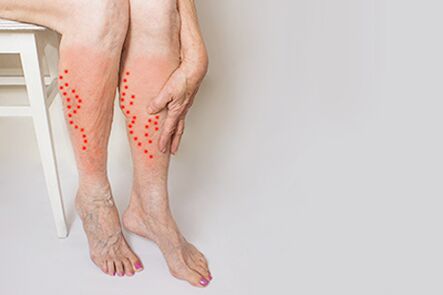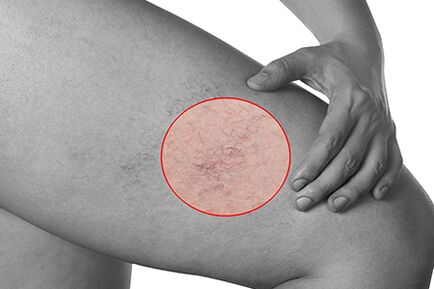If the veins in the legs are very large and clearly visible to the naked eye, then that's no reason to be proud at all (well, in fact, these aren't muscles). However, they don't look as attractive as the quadriceps. Therefore, most people usually hide them. Even from doctors. By the way, this is completely wrong. Because if you have any questions about the condition of your veins and blood vessels, then you should show them to a doctor who specializes in them - a phlebologist. But first, read this article: In this article, you'll learn how to treat leg varicose veins, what symptoms it has and what to do to get rid of it.
Varicose veins in the legs: symptoms

The symptoms of this disease depend on its stage:
Therefore, in the first stage, the patient is disturbed by a feeling of heaviness in the lower extremities, muscle cramps (more common during sleep), itching or burning, and swelling of the legs. Sometimes there is pain in the legs, especially in the venous area. There is often telangiectasia.
In the second stage, there is the vascular network and all the symptoms inherent in the first stage, but already more pronounced. In addition, the visibility of the veins is significantly increased: they can be observed even with the naked eye.
The third stage is characterized by all the symptoms mentioned above. At the same time, the swelling becomes almost permanent. Sometimes they can pass in the morning, but at the same time reappear at night.
In the fourth stage, the color of the skin changes. It may turn brown or even black. Inflammation occurs and skin atrophy is possible. In this case, blue or purple spots appear on it.
In the fifth and sixth stages, trophic ulcers are formed: healed and unhealed, respectively.
Varicose veins in the legs: treatment
Today, treatment of varicose veins in the legs can be done in several ways:
Laser ablation of veins. This is a high-tech procedure, performed using modern equipment - medical laser equipment. Equipped with a flexible light guide, the device is inserted through a puncture or incision into the lumen of the vessel in question to a certain depth. After that, the phlebologist turns on the instrument and the tip of the light guide begins to emit a continuous stream of light. The light has such a wavelength that the rays are absorbed by the walls of the veins, so they are heated and welded. Leg varicose veins can be treated more accurately and effectively with the help of ultrasound laser-controlled surgery. After a while, the glued veins dissolve. The light guide has a special design so that the entire inner circumference of the container can be treated at once. As the doctor gradually pulls out the light guide, the desired treatment length is achieved. The average session duration of laser ablation is 2-4. 5 hours, but this inconvenience is compensated by the fact that varicose veins are treated with only one laser ablation. And since the procedure requires a small incision (no more than 0. 3 cm), there is no need for sutures after the session.
venule resection. This procedure also requires a puncture or incision (nor more than 3 mm). The affected area of the vein needs to be extracted. After that, the phlebologist cuts the extracted vein and compresses its end. Treating leg varicose veins with this method does not involve sutures because the puncture is small - usually covered in a cast and bandaged. This is enough to heal.
Sclerotherapy. For this procedure, you do not need to make an incision - the session is fully injectable. Using a syringe, a special liquid (or in the form of a foam) is injected into the skin to hold the vein walls together. As in the case of laser vein occlusion, the glued blood vessels dissolve in the tissue after a period of time.
Surgical treatment of varicose veins in the legs. This procedure is performed using a local anesthetic. During the procedure, the doctor removes the skin in the area where the vein was excised, and then removes it. In addition, at the same time the cause of the backflow of blood is eliminated. After surgical treatment, a considerable recovery period is required, accompanied by mandatory dressings.
It's worth remembering that after all procedures are complete, you must follow certain directions that your doctor gives after completion. Therefore, it is necessary to give up tanning of any kind and not go to the sauna or bath for a few months after treating varicose veins in the legs. Prolonged standing or sitting is also prohibited. A special moment for program effectiveness and a faster recovery period is wearing compression bras. At the same time, for the first few days, it is enough to follow this rule around the clock. In the future, compression underwear will only be worn during the day. By the way, shoes that are uncomfortable at first (high heels, tight ones) also need to be discarded. For two to three weeks after surgery, comfortable, roomy shoes are recommended.
causes of varicose veins

Experts say one of the main reasons for the appearance and development of varicose veins in the legs is a genetic predisposition. Therefore, if one of the relatives is diagnosed with varicose veins, the risk of developing the disease will be significantly higher than those whose relatives do not have varicose veins. However, there are many other factors that can contribute to the development of varicose veins in the legs:
A sedentary lifestyle.
Wear uncomfortable shoes or high heels.
Postpone leg injuries.
Increased load: overweight, weightlifting.
Wrong nutrition.
Pregnancy and childbirth.
Cardiovascular disease.
Vascular tone is reduced.
Take certain hormone medicines.
Smoking and drinking.
Pelvic organ disease.
Persistent stress and emotional tension.
Blood viscosity is high.
Varicose veins are more common in older adults (because blood vessel tone decreases with age). However, it can also appear in young people under the age of 30. The disease affects both sexes.
Why you need treatment for varicose veins in your legs
If varicose veins in the legs are not removed (treatment) in time, various complications can occur, including trophic ulcers that do not heal. This ulcer can then lead to gangrene, which can be fraught with lower extremity amputations and disability. Also, the treatment of any disease is easier to do in the initial stages of the disease.
Also, do not forget the possible development of thrombophlebitis. One of the complications of this disease is pulmonary embolism, which is usually fatal.
prevent leg varicose veins
A good preventative measure for varicose veins in the legs is to wear compression underwear that provides even pressure on the entire surface of the leg. It is also recommended to follow other tips:
Don't neglect physical activity: cycling, swimming, walking, etc.
Avoid uncomfortable shoes (especially high heels).
Take a comparison bath.
Also, if you have a genetic predisposition to varicose veins (or other factors), consult a phlebologist at least twice a year.


















